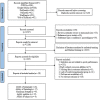Effect of unilateral training and bilateral training on physical performance: A meta-analysis
- PMID: 37123275
- PMCID: PMC10133687
- DOI: 10.3389/fphys.2023.1128250
Effect of unilateral training and bilateral training on physical performance: A meta-analysis
Abstract
Background: In Unilateral (UNI) exercises are more effective than bilateral (BI) exercises in improving athletic performance is debatable. Objectives: this meta-analysis investigated the effects of UNI and BI exercises on different effect indicators of jump ability, sprint ability, maximal force, change of direction ability, and balance ability. Data Sources: PubMed, Google Scholar, Web of science, CNKI, Proquest, Wan Fang Data. Study Eligibility Criteria: To be eligible for inclusion in the meta-analysis, the study had to be: 1) athletes; 2) UNI training and BI training; 3) the intervention period had to be more than 6 weeks and the intervention frequency had to be more than 2 times/week; 4) the outcome indicators were jumping ability, sprinting ability, maximum strength, and change of direction and balance. Study Appraisal and Synthesis Method: We used the random-effects model for meta-analyses. Effect sizes (standardized mean difference), calculated from measures of horizontally oriented performance, were represented by the standardized mean difference and presented alongside 95% confidence intervals (CI). Results: A total of 28 papers met the inclusion criteria, and Meta-analysis showed that UNI training was more effective than BI training in improving jumping ability (ES = 0.61.0.23 to 0.09; Z = 3.12, p = 0.002 < 0.01), sprinting ability (ES = -0.02, -0.03 to -0.01; Z = 2.73, p = 0.006 < 0.01), maximum strength (ES = 8.95,2.30 to 15.61; Z = 2.64, p = 0.008 > 0.05), change of direction ability (ES = -0.03, -0.06 to 0.00; Z = 1.90, p = 0.06 > 0.01) and balance ability (ES = 1.41,-0.62 to 3.44; Z = 1.36, p = 0.17 > 0.01). The results of the analysis of moderating variables showed that intervention period, intervention frequency and intervention types all had different indicators of effect on exercise performance. Conclusion: UNI training has a more significant effect on jumping and strength quality for unilateral power patterns, and BI training has a more significant effect on jumping and strength quality for bilateral power patterns.
Keywords: ability; bilateral exercises; explosive power; maximal force; unilateral exercises.
Copyright © 2023 Zhang, Chen, Xu, Xie, Li, Ding and Sun.
Conflict of interest statement
The authors declare that the research was conducted in the absence of any commercial or financial relationships that could be construed as a potential conflict of interest.
Figures






Similar articles
-
Effect of unilateral and bilateral plyometric training on jumping, sprinting, and change of direction abilities: a meta-analysis.BMC Sports Sci Med Rehabil. 2025 Apr 25;17(1):97. doi: 10.1186/s13102-025-01113-6. BMC Sports Sci Med Rehabil. 2025. PMID: 40281589 Free PMC article.
-
Effects of unilateral vs. bilateral resistance training interventions on measures of strength, jump, linear and change of direction speed: a systematic review and meta-analysis.Biol Sport. 2022 Sep;39(3):485-497. doi: 10.5114/biolsport.2022.107024. Epub 2021 Jul 3. Biol Sport. 2022. PMID: 35959319 Free PMC article. Review.
-
Meta-analysis of the intermittent time of post-activation potentiation enhancement on sprint ability.J Sports Med Phys Fitness. 2023 Jan;63(1):86-94. doi: 10.23736/S0022-4707.22.13502-4. Epub 2022 May 27. J Sports Med Phys Fitness. 2023. PMID: 35620952
-
Effects of Vertically and Horizontally Orientated Plyometric Training on Physical Performance: A Meta-analytical Comparison.Sports Med. 2021 Jan;51(1):65-79. doi: 10.1007/s40279-020-01340-6. Sports Med. 2021. PMID: 32897526
-
Effects of Jumping Exercise on Muscular Power in Older Adults: A Meta-Analysis.Sports Med. 2018 Dec;48(12):2843-2857. doi: 10.1007/s40279-018-1002-5. Sports Med. 2018. PMID: 30341594
Cited by
-
Effects of Unilateral, Bilateral and Combined Plyometric Jump Training on Asymmetry of Muscular Strength and Power, and Change-of-Direction in Youth Male Basketball Players.J Sports Sci Med. 2024 Dec 1;23(4):754-766. doi: 10.52082/jssm.2024.754. eCollection 2024 Dec. J Sports Sci Med. 2024. PMID: 39649573 Free PMC article. Clinical Trial.
-
A Comparison of Bilateral vs. Unilateral Flywheel Strength Training on Physical Performance in Youth Male Basketball Players.J Funct Morphol Kinesiol. 2025 Feb 27;10(1):81. doi: 10.3390/jfmk10010081. J Funct Morphol Kinesiol. 2025. PMID: 40137333 Free PMC article.
-
Unilateral Plyometric Jump Training Shows Significantly More Effective than Bilateral Training in Improving Both Time to Stabilization and Peak Landing Force in Single-Leg Lend and Hold Test: A Randomized Multi-Arm Study Conducted Among Young Male Basketball Players.J Sports Sci Med. 2024 Sep 1;23(1):647-655. doi: 10.52082/jssm.2024.647. eCollection 2024 Sep. J Sports Sci Med. 2024. PMID: 39228781 Free PMC article. Clinical Trial.
-
Effects of unilateral and bilateral complex-contrast training on lower limb strength and jump performance in collegiate female volleyball players.PLoS One. 2025 Jun 30;20(6):e0327237. doi: 10.1371/journal.pone.0327237. eCollection 2025. PLoS One. 2025. PMID: 40587589 Free PMC article. Clinical Trial.
-
A 12-week Taijiquan practice improves balance control and functional fitness in fall-prone postmenopausal women.Front Public Health. 2024 Jun 26;12:1415477. doi: 10.3389/fpubh.2024.1415477. eCollection 2024. Front Public Health. 2024. PMID: 38989125 Free PMC article.
References
-
- Abston L. (2020a). A comparison of unilateral and bilateral sagittal plane plyometrics on power outcomes in collegiate powerlifters. Louisiana, United States: University of Louisiana at Lafayette.
-
- Ahmad T., Jain D. R. (2020). Effects of lower body plyometric training in young Kashmiri female volleyball players. Int. J. Phys. Educ. Sports Health 7, 151–156.
Publication types
LinkOut - more resources
Full Text Sources
Miscellaneous

